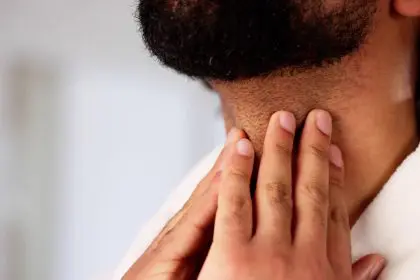You probably never thought twice about the way you breathe, assuming it’s just another basic biological function that everyone does pretty much the same way. Turns out, you couldn’t be more wrong. Scientists have just discovered that your breathing pattern is so uniquely yours that it works like a fingerprint, capable of identifying you with over 90% accuracy even after years have passed.
But here’s where it gets really mind-blowing. The same research suggests that your breathing patterns might be broadcasting information about your mental health, anxiety levels, and emotional state in ways that could revolutionize how we understand and diagnose psychological conditions. We’re talking about a discovery that could change everything from security systems to mental health treatment.
The implications are staggering when you consider that breathing is something we do constantly, unconsciously, and in ways that apparently reveal intimate details about who we are and how we’re feeling. This isn’t just another cool scientific discovery, it’s a fundamental shift in understanding how much our bodies reveal about our identities and inner lives.
The accidental discovery that changed everything
Researchers at the Weizmann Institute of Science in Israel weren’t trying to create a new form of biometric identification when they started studying breathing patterns. They were investigating how the brain processes smell and became fascinated by the constant cycle of inhalation and exhalation that most of us never consciously think about.
The team developed a wearable sensor that participants wore on their upper backs for 24 hours, with tiny tubes positioned to capture airflow from each nostril separately. What they discovered when they analyzed all that breathing data was completely unexpected and frankly a little unsettling.
Every single person had a breathing signature so distinctive that computer software could identify them from their breathing patterns alone. This wasn’t just a minor variation that required sophisticated analysis to detect, this was a clear, consistent pattern that remained stable over time and could distinguish between individuals with remarkable accuracy.
The consistency was particularly surprising. When about 40 participants returned nearly two years later for follow-up testing, their breathing patterns were just as identifiable as they had been originally. Your breathing fingerprint apparently doesn’t change, even over extended periods of time.
What makes your breathing uniquely yours
Understanding what makes breathing patterns so individual requires recognizing that there’s much more happening during each breath cycle than simple inhalation and exhalation. Every person has subtle but consistent quirks in how they breathe that create a unique signature as distinctive as their physical fingerprint.
Some people have very consistent pauses just before each inhale, while others vary the timing unpredictably. Certain individuals exhale very quickly while others take their time releasing air. The frequency of sighing, the balance of airflow between nostrils, and dozens of other micro-variations combine to create patterns that are apparently as individual as DNA.
These breathing characteristics aren’t random or temporary, they’re consistent expressions of how your individual nervous system, lung structure, nasal passages, and brain patterns work together to control respiration. The uniqueness stems from the fact that breathing is controlled by complex interactions between multiple body systems, each of which varies between individuals.
The discovery suggests that breathing patterns reflect fundamental aspects of how your body and brain function, creating signatures that remain stable over time because they’re based on underlying biological and neurological characteristics that don’t change significantly.
The mental health connection nobody saw coming
Perhaps the most intriguing aspect of this research involves the connections researchers found between breathing patterns and mental health indicators. Participants who scored high on anxiety, depression, or autism-related traits showed corresponding patterns in their breathing that could potentially be used for diagnostic purposes.
People with depressive traits, for example, tended to exhale very quickly, suggesting that mental health conditions might create measurable changes in how the respiratory system functions. These connections could revolutionize mental health diagnosis by providing objective, measurable indicators of psychological states.
The potential applications are enormous when you consider how difficult it can be to accurately diagnose and monitor mental health conditions. If breathing patterns can reveal information about anxiety, depression, or other psychological states, it could provide healthcare providers with new tools for early detection and ongoing monitoring.
The research also raises fascinating questions about whether breathing exercises and techniques could be developed to actively improve mental health rather than just managing symptoms. If specific breathing patterns are associated with better psychological states, training people to breathe in healthier ways might have therapeutic benefits that we’re only beginning to understand.
Privacy implications that should terrify everyone
The discovery that breathing patterns can identify individuals raises serious privacy concerns that most people probably haven’t considered yet. If your breathing is as identifying as your fingerprint, then any situation where your breathing patterns are recorded could potentially be used to track or identify you.
Consider how many places you breathe regularly where sensors could theoretically monitor your respiratory patterns. Hospitals, offices, cars, public transportation, stores, restaurants, and countless other locations could potentially collect breathing data that identifies you without your knowledge or consent.
The researchers themselves acknowledged these privacy implications, noting that lengthy recordings of breathing patterns might need to be protected under privacy laws the same way other biometric data is currently regulated. However, they also pointed out that brief recordings aren’t sufficient for identification, requiring at least 24 hours of data to achieve reliable results.
This timing requirement provides some protection against casual surveillance, but it also means that any situation involving extended monitoring could potentially compromise your privacy in ways you never anticipated. Medical devices, sleep monitoring equipment, or long-term health tracking systems could all theoretically collect enough breathing data to identify you uniquely.
What this means for the future of identification
While breathing pattern identification might not replace fingerprints or facial recognition anytime soon, it represents another tool in the expanding toolkit of biometric identification methods. The technology could be particularly useful in situations where other identification methods aren’t practical or available.
Medical monitoring represents the most obvious application, where breathing pattern identification could help ensure that health data is correctly attributed to specific patients while also providing insights into their psychological and physical conditions. Long-term health monitoring could benefit from the ability to track both identity and mental state through breathing analysis.
The technology could also have applications in security situations where other biometric methods aren’t feasible, though the requirement for extended monitoring periods limits its usefulness for quick identification purposes. The stability of breathing patterns over time could make them valuable for long-term identity verification in certain contexts.
Research applications could also benefit significantly from this discovery, allowing scientists to study connections between breathing patterns and various health conditions while ensuring accurate participant identification and data collection over extended periods.
The biological uniqueness we never knew we had
This breathing pattern discovery reveals something profound about human biological individuality that extends far beyond simple identification applications. The fact that something as automatic and unconscious as breathing carries unique signatures suggests that human individuality runs much deeper than we previously understood.
Every breath you take apparently reflects the unique way your nervous system, brain, and respiratory system work together, creating patterns that are as individual as your thoughts or personality. This suggests that biological uniqueness extends to unconscious processes in ways that could reshape our understanding of human individuality.
The connection between breathing patterns and mental health also suggests that our psychological states are more closely integrated with our physical functions than many people realize. Your mind and body aren’t separate systems, they’re deeply interconnected in ways that create measurable patterns in even the most basic biological functions.
The stability of these patterns over time also indicates that certain aspects of our biological signatures remain consistent throughout our lives, providing a form of biological continuity that persists even as other aspects of our bodies and minds change over time.
The questions this research raises
The discovery of breathing fingerprints opens up countless questions about human biology, privacy, and the future of health monitoring. If breathing patterns can reveal mental health information, what other unconscious biological processes might be broadcasting similar data about our psychological and physical states?
The research also raises questions about whether we can consciously modify our breathing patterns in ways that might improve our mental health or overall well-being. If certain breathing patterns are associated with better psychological states, could breathing training become a more targeted and effective form of therapy?
From a privacy perspective, the discovery forces us to consider what constitutes personal information and how biological data should be protected. If your breathing pattern can identify you and reveal information about your mental health, should that data be subject to the same protections as medical records or other sensitive personal information?
The research also suggests that many aspects of human individuality remain unexplored and poorly understood. If something as basic as breathing carries unique signatures, what other biological processes might reveal similar individual characteristics that we haven’t discovered yet?
The breath that reveals everything
The discovery that breathing patterns work like fingerprints represents more than just an interesting scientific finding, it’s a fundamental shift in understanding how much our bodies reveal about our identities and inner lives. The fact that something as unconscious and automatic as breathing carries unique signatures that can identify us and potentially reveal our mental health states should change how we think about privacy, individuality, and biological monitoring.
This research opens up possibilities for revolutionary advances in mental health diagnosis and monitoring while simultaneously raising serious questions about privacy and the security of biological data. As we develop new technologies for monitoring and analyzing human biological patterns, we’ll need to carefully balance the potential benefits with the need to protect individual privacy and autonomy.
The discovery also reminds us that human individuality extends far deeper than we previously understood, with unique biological signatures present even in the most basic and unconscious bodily functions. Your breathing isn’t just keeping you alive, it’s apparently broadcasting information about who you are and how you’re feeling in ways that science is only beginning to understand.


















